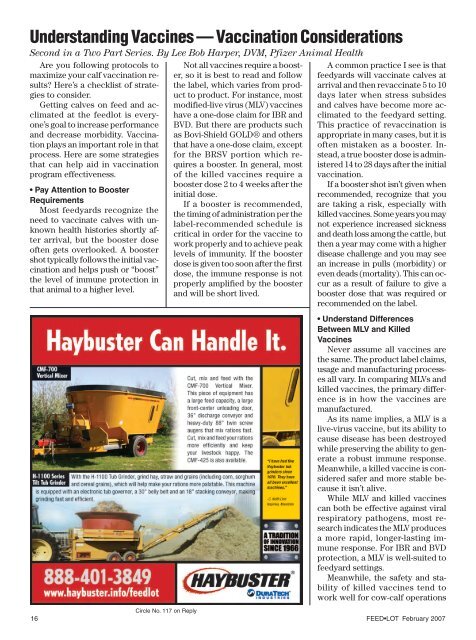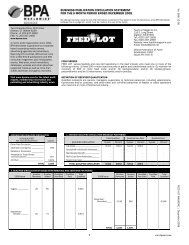February - Feedlot Magazine
February - Feedlot Magazine
February - Feedlot Magazine
- No tags were found...
You also want an ePaper? Increase the reach of your titles
YUMPU automatically turns print PDFs into web optimized ePapers that Google loves.
Understanding Vaccines — Vaccination ConsiderationsSecond in a Two Part Series. By Lee Bob Harper, DVM, Pfizer Animal HealthAre you following protocols tomaximize your calf vaccination results?Here’s a checklist of strategiesto consider.Getting calves on feed and acclimatedat the feedlot is everyone’sgoal to increase performanceand decrease morbidity. Vaccinationplays an important role in thatprocess. Here are some strategiesthat can help aid in vaccinationprogram effectiveness.• Pay Attention to BoosterRequirementsMost feedyards recognize theneed to vaccinate calves with unknownhealth histories shortly afterarrival, but the booster doseoften gets overlooked. A boostershot typically follows the initial vaccinationand helps push or “boost”the level of immune protection inthat animal to a higher level.Not all vaccines require a booster,so it is best to read and followthe label, which varies from productto product. For instance, mostmodified-live virus (MLV) vaccineshave a one-dose claim for IBR andBVD. But there are products suchas Bovi-Shield GOLD® and othersthat have a one-dose claim, exceptfor the BRSV portion which requiresa booster. In general, mostof the killed vaccines require abooster dose 2 to 4 weeks after theinitial dose.If a booster is recommended,the timing of administration per thelabel-recommended schedule iscritical in order for the vaccine towork properly and to achieve peaklevels of immunity. If the boosterdose is given too soon after the firstdose, the immune response is notproperly amplified by the boosterand will be short lived.A common practice I see is thatfeedyards will vaccinate calves atarrival and then revaccinate 5 to 10days later when stress subsidesand calves have become more acclimatedto the feedyard setting.This practice of revaccination isappropriate in many cases, but it isoften mistaken as a booster. Instead,a true booster dose is administered14 to 28 days after the initialvaccination.If a booster shot isn’t given whenrecommended, recognize that youare taking a risk, especially withkilled vaccines. Some years you maynot experience increased sicknessand death loss among the cattle, butthen a year may come with a higherdisease challenge and you may seean increase in pulls (morbidity) oreven deads (mortality). This can occuras a result of failure to give abooster dose that was required orrecommended on the label.• Understand DifferencesBetween MLV and KilledVaccinesNever assume all vaccines arethe same. The product label claims,usage and manufacturing processesall vary. In comparing MLVs andkilled vaccines, the primary differenceis in how the vaccines aremanufactured.As its name implies, a MLV is alive-virus vaccine, but its ability tocause disease has been destroyedwhile preserving the ability to generatea robust immune response.Meanwhile, a killed vaccine is consideredsafer and more stable becauseit isn’t alive.While MLV and killed vaccinescan both be effective against viralrespiratory pathogens, most researchindicates the MLV producesa more rapid, longer-lasting immuneresponse. For IBR and BVDprotection, a MLV is well-suited tofeedyard settings.Meanwhile, the safety and stabilityof killed vaccines tend towork well for cow-calf operationsCircle No. 117 on Reply16 FEED•LOT <strong>February</strong> 2007



